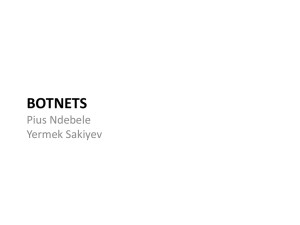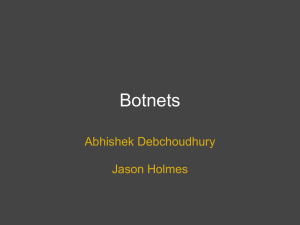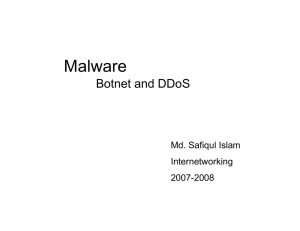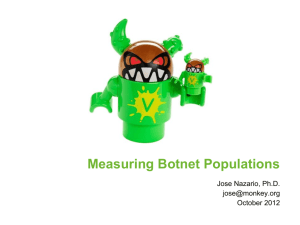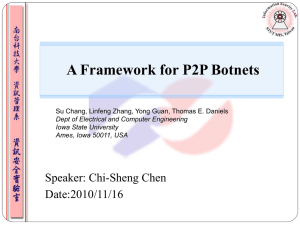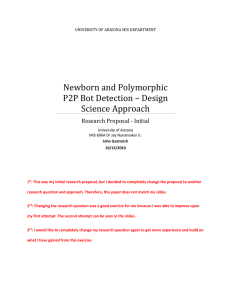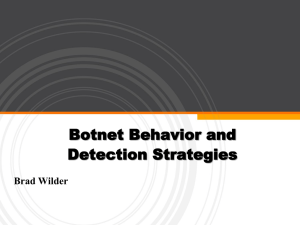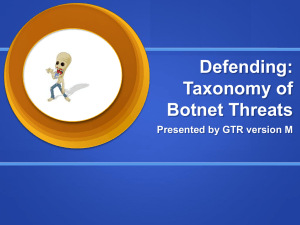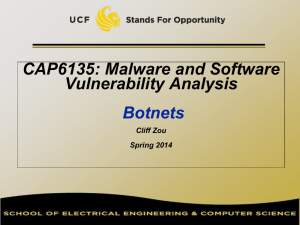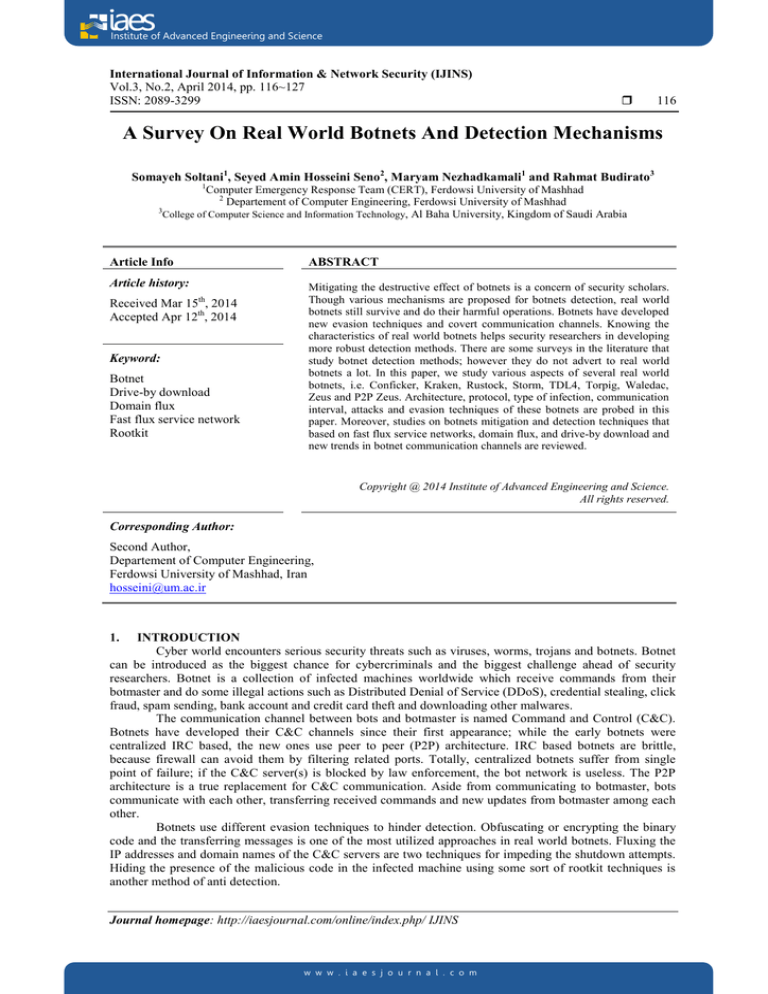
Institute of Advanced Engineering and Science
International Journal of Information & Network Security (IJINS)
Vol.3, No.2, April 2014, pp. 116~127
ISSN: 2089-3299
116
A Survey On Real World Botnets And Detection Mechanisms
Somayeh Soltani1, Seyed Amin Hosseini Seno2, Maryam Nezhadkamali1 and Rahmat Budirato3
1
Computer Emergency Response Team (CERT), Ferdowsi University of Mashhad
2
Departement of Computer Engineering, Ferdowsi University of Mashhad
3
College of Computer Science and Information Technology, Al Baha University, Kingdom of Saudi Arabia
Article Info
ABSTRACT
Article history:
th
Received Mar 15 , 2014
Accepted Apr 12th, 2014
Keyword:
Botnet
Drive-by download
Domain flux
Fast flux service network
Rootkit
Mitigating the destructive effect of botnets is a concern of security scholars.
Though various mechanisms are proposed for botnets detection, real world
botnets still survive and do their harmful operations. Botnets have developed
new evasion techniques and covert communication channels. Knowing the
characteristics of real world botnets helps security researchers in developing
more robust detection methods. There are some surveys in the literature that
study botnet detection methods; however they do not advert to real world
botnets a lot. In this paper, we study various aspects of several real world
botnets, i.e. Conficker, Kraken, Rustock, Storm, TDL4, Torpig, Waledac,
Zeus and P2P Zeus. Architecture, protocol, type of infection, communication
interval, attacks and evasion techniques of these botnets are probed in this
paper. Moreover, studies on botnets mitigation and detection techniques that
based on fast flux service networks, domain flux, and drive-by download and
new trends in botnet communication channels are reviewed.
Copyright @ 2014 Institute of Advanced Engineering and Science.
All rights reserved.
Corresponding Author:
Second Author,
Departement of Computer Engineering,
Ferdowsi University of Mashhad, Iran
hosseini@um.ac.ir
1.
INTRODUCTION
Cyber world encounters serious security threats such as viruses, worms, trojans and botnets. Botnet
can be introduced as the biggest chance for cybercriminals and the biggest challenge ahead of security
researchers. Botnet is a collection of infected machines worldwide which receive commands from their
botmaster and do some illegal actions such as Distributed Denial of Service (DDoS), credential stealing, click
fraud, spam sending, bank account and credit card theft and downloading other malwares.
The communication channel between bots and botmaster is named Command and Control (C&C).
Botnets have developed their C&C channels since their first appearance; while the early botnets were
centralized IRC based, the new ones use peer to peer (P2P) architecture. IRC based botnets are brittle,
because firewall can avoid them by filtering related ports. Totally, centralized botnets suffer from single
point of failure; if the C&C server(s) is blocked by law enforcement, the bot network is useless. The P2P
architecture is a true replacement for C&C communication. Aside from communicating to botmaster, bots
communicate with each other, transferring received commands and new updates from botmaster among each
other.
Botnets use different evasion techniques to hinder detection. Obfuscating or encrypting the binary
code and the transferring messages is one of the most utilized approaches in real world botnets. Fluxing the
IP addresses and domain names of the C&C servers are two techniques for impeding the shutdown attempts.
Hiding the presence of the malicious code in the infected machine using some sort of rootkit techniques is
another method of anti detection.
Journal homepage: http://iaesjournal.com/online/index.php/ IJINS
w w w . i a e s j o u r n a l . c o m
IJINS
ISSN: 2089-3299
117
Various real world botnets come into existence in recent years. Having detailed information about
them, makes more robust detection mechanisms and vice versa. For example while much of normal
communication between bots in P2P Zeus, P2P Conficker, Kraken and Storm is based on UDP [1-8]
detection techniques presented in [9, 10] filter out UDP flows to reduce the big volume of captured traffic. In
this paper we focus on some of real world botnets and discuss their architectures, types of attacks and evasion
techniques respectively. Moreover various existing detection techniques are described in this survey.
The rest of the paper is organized as follows. Section 2 reviews the related works. An overview of
real world botnets is explained in section 3. Different attacks done by real world botnets are illustrated in
section 4. Section 5 describes various evasion techniques used by botnets to hinder detection and tracing.
Detection techniques are described in section 6. Section 7 explains some new trends in C&C communication
and section 8 concludes the paper.
2.
RELATED WORK
Several surveys on botnets are proposed by researchers in [11-14]. The technical report in [11]
presents a comprehensive survey on botnet measurement and detection techniques. Different passive
techniques including packet inspection, analysis of flow records, DNS-based approaches, analysis of spam
records, analysis of application log files, honeypots and evaluation of anti-virus software feedback are
probed. Active detection techniques including sinkholing, infiltration, DNS cache snooping, detecting fastflux networks, IRC-based botnets detection and P2P botnets detection are studied. Various botnet mitigation
schemes are illustrated too. The survey in [12] offers botnets history, components of a botnet, characteristics
of a bot, life cycle of botnets and architectural designs. It also classifies botnet detection techniques into two
categories, host-based and network-based techniques. However [11, 12] do not focus on real world botnets.
Another older survey [13] works on classification and attacks of botnets and studies some IRCbased real world botnets, i.e. Agobot, SDbot, Spybot and GTbot. However new evasion techniques used by
botnets and new real world botnets are not studied in this work. A survey on new evasion techniques
including fast flux and domain flux is presented in [14]. The survey illustrates these defense mechanisms and
compares techniques proposed for detection of them.
3.
AN OVERVIEW OF REAL BOTNETS
In this section several generic characteristics of some real world botnets i.e. Conficker, Kraken,
Rustock, Storm, TDL4, Torpig, Waledac, Zeus and P2P Zeus are explained. Table 1 shows the characteristics
of these botnets. The creation or detection date, architecture, protocol, attack vector, number of peers in P2P
networks, communication interval between bot and botmaster or other peers and estimated number of
zombies of these botnets are illustrated in this section. Two principal botnet architectures are centralized and
peer to peer. Some botnets like Conficker and Zeus change their architectures in new variants from
centralized to P2P. Recent botnets mostly use HTTP, TCP and UDP as their communication protocol.
However some botnets like Storm and TDL4 use special P2P network protocols [15].
Botnets use various methods to infect machines worldwide. Attack vectors range from simple USB
drive propagation to sophisticated drive-by downloads. Conficker A propagates by exploiting the MS08-67
vulnerability in the Server Service which gives complete control of the infected machine remotely to the
attacker [16-18]. Besides exploiting MS08-67, conficker B uses two other attack vectors. It tries to find other
vulnerable machines in local network through NetBIOS scan and copies itself as autorun.inf to USB drives
[16, 17]. The main propagation method used by Waledac is through sending tempting emails containing
malware binary or links to malicious sites. It persuades users to click on links using social engineering
techniques such as Christmas or Valentine's Day topics [19-21]. Zeus uses both spam emails and drive-by
downloads to infect systems. The more a vulnerable machine visits a malicious site, causes more the
vulnerable machine be infected with the malware [22].
Bots in P2P architecture communicate with each other to exchange commands, binaries and some
information. Usually information of several peers is hard coded in the malware by botmaster. However bots
can find peers actively and update their peer list accordingly. P2P Zeus for example has information of 50
peers in its hard code. Each bot checks the responsiveness of its peers every 30 minutes within five retries. If
a peer does not respond, it will be omitted from peer list of the bot. Every message transferring among bots
have the identifier of the source bot. So if a bot receives a message from another bot which is not previously
in its peer list, it will be added to the peer list of the bot. In case the number of peers of a bot becomes short
(less than 25), a peer list request message is sent to bot's neighbors.
Conficker C uses different mechanism in finding peers. There is not any seed list of peers in
malware code; instead some scanning threads search the local network and global Internet for peers. An array
A Survey On Real World Botnets And Detection Mechanisms (Somayeh Soltani)
118
ISSN: 2089-3299
of 100 random IP addresses for local network search and another array of 100 IP addresses for global Internet
are generated. Then TCP and UDP scanners try to connect to these IP addresses on some precomputed ports.
When a peer is discovered, a peer session will be established.
Bots communicate with other entities for several reasons. Bots need to communicate to botmaster to
receive commands and binary updates and send sensitive data stolen from the infected machines. In P2P
networks, bots exchange information with each other. For synchronization purposes, bots may connect to
time servers as in Storm botnet [23] or acquire time from some known web sites like google.com as in
Conficker C. These communications usually take place in specific time intervals and make some repetitive
patterns which can be used by analysts for detection purposes. Conficker A queries each of domains
generated by a DGA algorithm every three hours. In Zeus, a message containing main status information
about the zombie such as botID, IP address, bot OS is sent to botmaster every two minutes. Moreover another
message containing stolen data is sent to botmaster every ten minutes [24]. Torpig bots contact every twenty
minutes to their C&C server to upload the stolen data [25]. Bots in P2P Zeus check the responsiveness of
their peers every thirty minutes.
Table 1. Botnets Overview
* Check connectivity
Name
Creation
(Detection
) Date
Architecture
Protocol
Type of infection
Number of
Peers
Communicatio
n Interval
Number of
Zombies
(All
variants)
10.5
million till
2009 [26]
Conficker
A
November
2008
Centralized
HTTP [16,
17]
MS08-067 exploit
[16, 17]
-
Every 1
minute*, Every
3 hours** [16,
17]
Conficker
B
December
2008
Centralized
HTTP [16,
17]
MS08-067 exploit,
NetBIOS Share, USB
[16, 17]
-
Every 1
minute*, Every
2 hours** [16,
17]
-
Conficker
B++
February
2009
Centralized
HTTP [16]
MS08-067 exploit,
NetBIOS Share, USB
[16]
-
-
-
Conficker
C
March
2009
P2P
TCP,
UDP,
HTTP [3,
4]
Updated from
previous variants [3,
27]
scans the
Internet
looking for
other peers
[3, 4]
-
-
Conficker
E
April 2009
P2P
TCP,
UDP,
HTTP [27]
UDP, TCP
[5, 6]
MS08-067 exploit,
NetBIOS Share, USB
[27]
Social Engineering
[5]
-
-
-
-
-
HTTP
Spam email [30]
-
-
Kraken
Rustock
Late 2006
[28]
Around
2006
Centralized
P2P [29]
Storm
Mid 2006
[32]
P2P [7, 8,
33, 34]
UDP+
Overnet/
eDonkey
[7, 8]
Spam email plus
social engineering
techniques and clientside vulnerabilities
[7, 32, 33]
TDL4
2010
P2P
HTTP,
Kad
network
[15]
Drive-by downloads
[35], MS10-092
vulnerability [36]
Centralized
HTTP [25]
P2P [19, 20]
HTTP [19,
20]
Torpig
Waledac
April 2008
[19]
Zeus
2006 [24]
Centralized
[38]
HTTP [38]
Zeus
(P2P)
September
2011 [1]
P2P [1, 2]
UDP/TCP
and
HTTP [1,
2]
IJINS Vol. 3, No. 2, April 2014 : 116 – 127
Drive-by downloads
[25]
Spam emails using
social engineering
techniques [19-21] ,
Drive-by downloads
[19]
Spam emails using
social engineering
techniques,
Drive-by downloads
[22]
Spam emails [1]
100 [8],
290 [7] ***
every 10
minutes [7]
-
-
-
Every 20
minutes [25]
500 [19]
-
-
Every 2
minutes and 10
min [24]
50 [1]
Every 30
minutes [1]
400.000 till
2008 [28]
1.3 million
[31]
between 1
million and
5 million
[7]
Over 4.5
million till
2011 [15,
35]
180.000 till
2009 [25]
90.000
Till 2010
[37]
3.6 million
(US only)
Till 2009
[38]
200.000
[39]
IJINS
ISSN: 2089-3299
119
** Query the list of domains generated by DGA
*** Number varies based on Strom version
4.
REAL WORLD BOTNET ATTACKS
Botmaster spread its malware to different machines worldwide to perform its malicious activities.
Table 2 demonstrates some types of attack have been done by various botnets. Distributed denial of service
attacks are designed to overwhelm the communication bandwidth and computational resources of the victim
server and stopping it from servicing to its normal clients. Storm uses two types of DoS attack, i.e. TCP syn
flood and ICMP ping flood and attacks some anti-spam sites and antivirus web sites [7, 8, 33, 34]. Moreover
Rustock, TDL4, Waledac and P2P Zeus have the DDoS code in their binaries [1, 2, 19, 35, 40].
Malware infects a machine by using spam emails and social engineering techniques which later on
to infect other systems and to disseminate other types of malware. Kraken and Storm are two famous botnet
spammers. Storm in one of its peak day is responsible for 99% of all spam emails seen by a large service
provider [41]. One single Kraken bot has sent up to 500,000 pieces of spam in a day [28]. Rustock, TDL4,
Waledac and Zeus are some other spammer botnets.
Stealing sensitive information from infected machine is one of the common events takes place by
bots. Web site login credentials, cookies, credit cards, banking accounts and passwords are some of important
information which is thieved by botnets. Botnets use different methods to steal aforementioned information.
Torpig steals bank account and credit card information using man-in-the-browser phishing attacks. Torpig
configuration file contains about 300 domains of banks and financial institutions. It also steals a variety of
other personal Information. Zeus which is the largest bank theft botnet, hooks network APIs to steal network
related information.
Other malicious activities are done by different botnets. Zeus botmaster may occasionally ask its
bots to send him a snapshot of the system screen [24]. TDL4 does click fraud which increases the number of
clicks on an advertisement on a site and has benefits for owner of the site [35, 36, 42]. It also does bitcoin
operations [43]. Waledac downloads and installs a ransomware which is a fake antivirus, warning users about
some threats in their systems and inciting them to buy the full version of the antivirus [19, 20]. Zeus installs
CryptoLocker ransomware which encrypts some files on user systems and prompts user to send a ransom in
order to receive the decryption tool [44].
TDL4 is used for malware dissemination; it downloads other malicious programs to the host
computer [15, 35, 36]. Moreover TDL4 searches the system for any competitor’s malware and removes it
[15, 35]. Though having a lot of zombies, Conficker does not perform any serious attack yet. Only Conficker
E includes Waledac which used for spam sending [27].
Table 2. Botnet Attacks
Name
DDoS Attacks
Conficker
Kraken
Rustock
Storm
TDL4
Torpig
Waledac
Yes [40]
Yes [7, 8, 33, 34]
Yes [35]
Yes [19]
Spam
Sending
Yes [5, 6, 28]
Yes [45]
Yes [7, 32, 33]
Yes [35]
Yes [19, 20]
Zeus
-
Yes [22]
Zeus
(P2P)
Yes [1, 2]
-
Password theft
steal sensitive information [46]
Yes [35]
Yes [25]
capture login information [19, 21]
Steal passwords, credentials and
banking information [24]
steal crypto certificates, steal cookies
[1], Steal banking information [2]
5.
REAL WORLD BOTNET EVASION TECHNIQUES
Botnets use various techniques to elude tracing. Table 3 shows some of these techniques including
IP address flux, domain flux, binary obfuscation or encryption, encrypted or obfuscated communication and
rootkit.
IP address fluxing or Fast Flux Service Network (FFSN) is an evasion technique which is used in
some of recent botnets such as Waledac and Storm [7, 20, 34]. FFSN maps a single fully qualified domain
name to different set of IP addresses. These IP addresses belong to infected systems scattered in the world.
Botmaster chooses some of its zombies as front-end servers, setting their IP addresses in the response of DNS
queries in A records. One can see these A records by means of Dig tool which is part of BIND name server
software [47]. Intercepting the C&C channel by these proxy servers, the real hidden server is protected from
A Survey On Real World Botnets And Detection Mechanisms (Somayeh Soltani)
120
ISSN: 2089-3299
shutdown attempts. To achieve a secure scheme, a short Time-to-Live (TTL) is considered for each DNS
record and a new set of zombies act as front-end servers.
Domain flux is another evasion technique used wildly in recent botnet such as Kraken, Conficker,
Torpig, TDL4 and P2P Zeus [1-3, 6, 25, 42]. Botmaster changes domain name of C&C server periodically in
order to elude tracking and shutdown attempts. Bots have a Domain Generation Algorithm (DGA) embedded
in their code, which using a seed generates a random domain list. Then bot tries to connect to each of these
domains by sending DNS query. Just one (or a few) of these domains which is recently registered by
botmaster answers the query with IP address of the domain. Other queries are responded with an NXDomain
response.
P2P Zeus generates 1,000 domains per week. Domain generation algorithm first creates a MD5 hash
over concatenation of the year, month, day and domain index, which is used to generate domain names. The
top-level domain (TLD) is selected from one of the six top-level domains and concatenated to the domain
name [1, 2]. Conficker A and B generate 250 domain names per day and use UTC date for seed. Conficker A
selects a TLD randomly from five famous TLD and appended to the domain name. The number of TLDs
increases to eight in Conficker B [16].
In response to collaboration of Microsoft, ICANN and several security team to disable Conficker's
domains [48], Conficker C generates 50,000 random domains per day. The TLD concatenated to each
domain is selected randomly from 110 TLDs. However each bot just sends DNS query to 500 of these
domains. If none of these 500 domains are registered by botmaster, bot sleeps for 24 hours, and then will
generate a new list of 50,000 domains [3]. Kraken uses a random word generator that constructs Englishlanguage alike words containing vowels and consonants properly. The generated word is appended with a
suffix chosen randomly from a list of common nouns, verbs and adjective and adverb suffixes [49].
To harden the analysis of the binary file, botnets use some kind of obfuscation or encryption.
Moreover to enable validating the code, digital signature is appended to it. The binary file in Conficker A is
encrypted using the symmetric stream cipher RC4 with a password which is constructed by SHA-1 hash of
the binary file. Then this encrypted file is signed by RSA algorithm. The signature is appended to the
encrypted binary. Bots after receiving the binary file will validate it to ensure that it is signed by Conficker
authors [3, 16]. In Conficker B, authors use a new presented hashing algorithm, i.e. MD-6 instead of SHA-1
[3]. Binary files in P2P Zeus are signed with an RSA-2048 signature of the MD5 hash of the plaintext data
and are encrypted with RC4 algorithm using a hardcoded key plus XOR encryption [1].
Encrypting the communication messages hinders detection of botnets. Bots of Torpig periodically
contact the C&C server to upload stolen data. A simple obfuscation mechanism using XOR and base64
encoding protects this communication [25]. P2P Zeus has various types of messages, some of which are
protected using different encryption and signing techniques. For example, TCP data request is encrypted with
RC4 using the identifier of the recipient as the key. Botmaster may choose one bot as proxy by issuing the
proxy announcement message which is signed by RSA-2048 [1].
Botnets use rootkit techniques to hide its presence on a system, steal sensitive data from the system
and disable security products. User mode API hookings including IAT hooking and inline hooking are the
simplest rootkit techniques. IAT hooking takes place by exchanging one (or more) entry of import address
table of a binary with the address of malicious code. For example to hide malware related files and
directories in Windows Explorer, malware can change the IAT entry of NtQueryDirectoryFile in explorer.exe
process and replace it with malicious code which filter out the malware files and directories. Inline hooking
takes place by directly changing the API function. For the above example it is sufficient for the malware to
patch code of NtQueryDirectoryFile in Ntdll.dll and divert its execution somewhere in the code to malicious
code [50, 51].
User mode API hooking though simple, involves injecting a DLL to every process that need the
changes and may not work for some API functions. Kernel mode rootkits are more robust but need more
precise programming; any bug found in the code yields system crash. One simple kernel mode hooking
involves exchanging the SSDT table entries with the malicious code. This hooking needs more programming
efforts compared to user mode API hooking. All user modes and kernel modes API hooking can be detected
by rootkit revealers like Gmer [52].
Runtime patching the native APIs is another rootkit technique which is detected harder. Though
Microsoft protects some data structures like SSDT from changing in 64-bit operating systems using Kernel
Patch Protection (KPP) or PatchGuard technique [53], malware can bypass this protection technique. Direct
Kernel Object Manipulation (DKOM) is the most sophisticated rootkit method used by some malware. Even
if online rootkit revealer like Gmer [52] cannot detect this type of rootkit, offline digital forensic tools like
Volatility [54] are powerful enough to detect this rootkit [51].
Real world botnets use some kind of rootkit to hide their processes and resources or disable security
products or steal information. Zeus hooks some network related APIs to steal information before sending
IJINS Vol. 3, No. 2, April 2014 : 116 – 127
IJINS
ISSN: 2089-3299
121
through the network [24]. Torpig uses a rootkit which replace the system's Master Boot Record (MBR) and
executes at boot time [25]. Storm performs kernel mode hooking to hide malware files and drivers [7, 8, 32,
34].
To remain undetected, real world botnets do some self defenses. Conficker Disables security
products, Disables AutoUpdate, Blocks DNS lookups related to security applications, deactivates safeboot
mode and disables Windows' firewall protection of certain high-order UDP and TCP ports [3, 16, 17]. Storm
disables security products and windows file protection. It can detect debuggers and virtual machines and
accordingly falls into an infinite loop [7, 34]. TDL4 bypasses PatchGuard and the Windows code integrity
mechanism and performs anti debugging checks [36, 55]. P2P Zeus injects its code into other processes'
memory, therefore hides its network activities [2].
Table 3. Botnet Evasion Techniques
Botnet
Name
Fast Flux
Service Network
Domain
Flux
Conficker
No
Yes [3, 16]
Kraken
Rustock
No
No
Yes [6, 49]
No
Binary
Encryption,
Obfuscation and
signature
RC4, MD6, SHA1, RSA [3, 16]
Yes [5, 28]
No
Storm
Yes [7, 34]
No
TEA [34]
Encrypted
Communication
Yes [3]
Yes [5]
TLS [56]
-
Rootkit
(API Hooking)
Yes (User Mode API Hooking) [3,
16, 17]
Yes [5]
Yes (Kernel mode rootkit) [46]
Kernel rootkit for hiding malware
files and drivers [7, 8, 32, 34]
TDL4
Yes [15]
Yes [42]
RC4 [55]
Torpig
No
Yes [25]
-
Waledac
Yes [20]
No
Bzip2,AES [19,
20]
Base62, proprietary
encryption using XOR
[15]
XOR, base64 encoding
[25]
Bzip2, AES-128-CBC,
Base64, RSA keys [20]
Zeus
No
No
XOR, RC4 [57]
XOR, RC4 [24, 38, 57]
User mode API hooking to steal
sensitive information [24]
Zeus
(P2P)
No
Yes [1, 2]
RSA-2048, RC4,
XOR, MD5 [1]
RC4, RSA-2048, MD5,
XOR, zlib [1]
-
an MBR based rootkit named
Alureon (32bit/64bit rootkit) [15]
an MBR based rootkit named
Mebroot [25]
-
6.
DETECTION MECHANISMS
In this section various techniques for detection of IP and domain flux, drive-by download attacks
and presence of bots in a single host or in a monitored network are examined.
6.1 Detecting fast flux service networks
The first study that introduces the FFSN is [58]. Holz et al. [59] probe the matter and propose a
metric for detection of FFSN. According to their investigation, about 30% of domains advertised in spam are
FFSNs. They compare FFSN with two other techniques, Round Robin DNS (RRDNS) [60] and Content
Distribution Network (CDN). RRDNS is a load balancing technique used by large websites which returns a
list of A records in response to DNS queries. The response list is cycled in a round-robin manner for each
query. CDN is an advance load balancing method which distributes data among different far apart servers.
While servers in a CDN scatter around the world, the servers in a RRDNS are located in a same place. These
two techniques are similar to FFSN in the number of A records in DNS responses. Also the CDN technique is
similar to FFSN because of its low TTLs.
[59] presents some distinguishing parameters to detect FFSNs from benign domains: 1) nA, the
number of unique A records returned in all DNS queries. 2) nNS, the number of nameserver (NS) records in
one single query. 3) nASN, the number of unique ASNs for all A records. They represent a metric named
fluxiness (
) to distinguish FFSNs from CDNs. nsingle is the number of A records returned in a
single DNS query. For benign domains without the usage of CDNs, this metric is equal to one. But for CDNs
and FFSNs, the fluxiness metric is greater than one.
[59] also proposes another metric based on above parameters named flux-score using a weight
vector w and a bias term b:
A flux-score f(x)>b indicates an instance of a FFSN and f(x)<b correspond to benign domains.
Another study in this field is FluXOR [61], a system to monitor and detect FFSNs. FluXOR extracts
nine distinguishing features from domains which categorized in three groups: 1) features relating to domain
name, 2) features relating to availability of the networks and 3) features relating to heterogeneity of the
agents.
A Survey On Real World Botnets And Detection Mechanisms (Somayeh Soltani)
122
ISSN: 2089-3299
FluXOR is a system with three components: 1) Collectors which collect suspicious hostnames from
emails, 2) Monitors which extract some distinguishing features from domains. Once a domain is tagged as
FFSN, the monitor tries to find the proxy servers (i.e. botnet zombies) by acting like a zombie and querying
the DNS records. 3) A detector which combines the aforementioned features using a naïve Bayesian
classifier. The study shows 7.8% of hostnames collected from spam emails monitored by FluXOR for a
month were associated with FFSNs.
Flux-score [59] and FluXOR [61] use some temporal metrics such as the number of total A records
or the number of autonomous systems for detection of FFSNs. Temporal metrics though accurate, need
considerable time (i.e. the TTL of A record) to decide about the domain, which delay the detection.
Meanwhile the bot harder dictates many of his malevolent orders to his zombies and uses some other
techniques like domain flux to exchange the domain to a new registered one. Researches in [62-64] propose
some real time detection schemes.
Spatial Snapshot Fast-Flux Detection (SSFD) [62] is a detection scheme which maps IP addresses in
DNS responses to geographical coordinates using hostip.info [65]. SSFD defines two spatial measures,
spatial uniform distribution estimation and spatial service relationship evaluation, for detecting FFSNs.
Spatial uniform distribution estimation is an entropy-based function which estimates the uniform geographic
distribution of proxy servers (i.e. zombies). Because this measure cannot differentiate CDNs from FFSNs, the
service relationship measure is presented. The authors of [62] acclaim that the real time SSFD system is more
effective and efficient than flux-score based detection system [59].
In [64], a Genetic-based ReAl-time DEtection (GRADE) system is proposed. GRADE defines two
new measures, the Entropy of Domains of Preceding Nodes (E-DPNs) and the Standard Deviation of Round
Trip Time (SD-RTT) between the analyzer system and all A record host. Analyzing the results of the
traceroute command, GRADE estimates the heterogeneity of the domains of the preceding nodes of all A
record hosts. The preceding domains of A records associated with CDNs and RRDNSs will exhibit a high
degree of homogeneity. But the preceding domain of A records relating to FFSNs will show considerable
heterogeneity. For benign domains using CDN technique, the SD-RTT metric is small. But for FFSNs
because of the scatter model of proxy servers, the SD-RTT is a large value.
GRADE uses four metrics nA, nASN, E-DPN and SD-RTT and plugs these metrics into a linear
decision function. To determine the best set of weights for the decision function, a genetic algorithm is
employed. Experimental results show that GRADE classifies domains in a few second and with high
accuracy. The authors of [64] claim that GRADE achieves higher detection accuracy compared to flux-score
[59], FFBD [63] and SSFD [62].
6.2 Detecting domain flux
One straightforward solution to detect domains generated algorithmically by a botnet, is to reverse
engineer the malware executable which is resource and time intensive and is not always feasible [49, 66].
Antonakakis et al. [66] present a detection system called Pleiades based on the number of NXDomain
responses created in querying the DGA-generated domains. They test their system in a large ISP network and
cluster NXDomains based on their similar syntactic features and the number of overlapping compromised
machines that query them. Then (if possible) they assign these clusters to models of known botnet DGAs.
Malicious automatically generated domain names are detected in [67] using Stateful-SBB. A dataset
of benign and malicious domain names is used in training and test phase. Different classification algorithms
including Naïve-Bayes, C4.5, AdaBoost, SBB and Stateful-SBB are applied to identify malicious domain
names. Since classifiers other than Stateful-SBB require the data set to be feature-based, 17 different features
are extracted for each domain name. The Stateful-SBB classifier and C4.5 classifier provide high accuracy on
classification. Though Stateful-SBB classifies domains without requiring any a priori knowledge, however
other classifiers require a set of features.
6.3 Detecting drive-by download attacks
Drive-By Download (DBD) attack is a growing type of attack which takes place when a user visits a
web page containing malicious codes. The Malicious code is silently downloaded to the user system and
executed without the user consent. Often a drive-by download attack is done in three phases. 1) Shellcode
injection phase: that takes place through a malicious active client-side content (such as JavaScript) within a
malicious site or a legal site which is exploited by an attacker, 2) Shellcode execution phase: which uses a
vulnerability in the browser or its plug-in components to detour the control flow to the shellcode and execute
it and 3) Malware download and install: which silently downloads the malware (bot) code from remote
server, store it in the system and execute it on the host operating system.
Researches in [68-72] have probed this type of infection and propose solutions to mitigate it.
BLADE [68] for example is an attack-agnostic system that prevents drive-by malware installation. Placing
IJINS Vol. 3, No. 2, April 2014 : 116 – 127
IJINS
ISSN: 2089-3299
123
BLADE as a dynamic loadable driver into the OS can successfully prevent the execution of binaries which
are downloaded without user consent.
BLADE consists of five components. Screen Parser monitors kernel windowing events to detect
appearance of a download consent dialog (a dialog box for asking permission from user) and notify the
Supervisor. To track user interaction with this dialog box (clicking Yes or No button), the Hardware-Event
Tracer is invoked by the Supervisor. Hardware-Event Tracer intercepts mouse and keyboard input events to
detect those that relate to the download consent dialog. Correlator matches a downloaded file to a tuple (u,p)
where u is the URL from which file is downloaded and p is the file system path where file is saved. The I/O
Redirector establishes a secure zone, a location where all binaries downloaded by the browser and its child
processes are placed. Execution of files in this area is prohibited by blocking memory-section
synchronizations. Files that are downloaded by the user consent, subsequently moved out of the secure zone.
Authors of [68] have evaluated the proposed scheme for some common browsers against some
active malicious sites. BLADE successfully detects and blocks all DBD infections with zero false positives.
Egele et.al. [70] propose a DBD detection scheme which is based on detection of shellcode in
JavaScript strings. Binary representation of shellcode is typically assigned to JavaScript string variables in
the address space of the browser. To facilitate the execution of shellcode, attacker put multiple instances of
the shellcode combined by a NOP sledge in different strings. All strings that are allocated by the JavaScript
interpreter are monitored for presence of shellcode using the libemu library [73]. Starting from each character
of the string, libemu checks whether there is a sequence of valid instructions in the string. These checks are
done before a vulnerability can be abused to divert control flow to the shellcode. If the system finds such a
string, the corresponding script is terminated.
The proposed scheme has been implemented by extending Mozilla Firfox and its JavaScript engine,
SpiderMonkey [74]. The implemented scheme can detect drive-by downloads that exploit memory corruption
vulnerabilities and use JavaScript code for launching the exploit with zero false positive. However, the
scheme cannot detect and protect other types of DBDs.
In [69], an anomaly-based approach for detection of drive-by download attacks which use malicious
JavaScript code is presented. First some distinguishing features in a DBD attack life cycle are defined. Using
these features and some machine-learning techniques, the system can identify anomalous JavaScript code.
The features are related to different phases of an attack, namely redirection and cloaking, deobfuscation,
environment preparation and exploitation.
Number and target of redirection, browser personality, ratio of string definitions and uses, number
of dynamic code executions, length of dynamically evaluated code, number of bytes allocated through string
operations, number of likely shellcode strings, number of instantiated plugins, values of parameters in
method calls and sequences of method calls are ten features proposed by [69]. The implemented tool called
JSAND is available online in [75] that analyzes and gives detailed reports for URLs or files sent by any user.
However, the proposed scheme does not prevent or block any attacks.
6.4 Botnet detection
In this section several botnet detection techniques are presented. We study recent works on botnet
detection that are not discussed in previous surveys [11, 12].
First, we discuss a work from Huang [76]. This work presents a host-based detection system based
on network failure model. The author assumes that network failures is an inherent property of botnet traffic
which results from unavailability of C&C server, a peer or the attacked target. Huang’s work shows that
network failure patterns of normal, peer-to-peer and botnet traffic are distinguishable and classifies them
using the C4.5 decision tree classifier. The system workflow consists of 1) collecting numerous benign, peerto-peer and bot traces, 2) filtering out non-failure traces, 3) extracting features from failure flows and 4)
building the classifier. To filter out non-failure traffic, this work defines possible type of failures, most of
which relate to transport protocols, TCP and UDP. For example receiving a TCP reset (RST) or an ICMP
unreachable in response to a TCP SYN, is considered as failure. In the feature extraction phase, this work
presents thirty four features of failure flows which can be classified into six categories: certain types of
failures, average interval between failures, total number of failures, ratio of distinct destination port numbers,
ratio of distinct destination IP addresses and average number of failures per destination IP address. The
author believes that the proposed model can detect bot hosts with more than 99% accuracy.
The second work is a botnet detection method based on group activities of bots as presented in [23].
The work is an improvement of the authors' previous works [77, 78]. The detection scheme named BotGAD
works by capturing group activities from DNS traffic. Though Botnet group activities are more shown in
centralized botnets, some P2P botnets may have the same activities. DNS traffic while having a small portion
of network traffic, enables botnet detection at its early stages, maybe prior to performing attacks.
A Survey On Real World Botnets And Detection Mechanisms (Somayeh Soltani)
124
ISSN: 2089-3299
Botnet group activities include C&C server or update server lookup as well as victim lookup. In
centralized model, bots frequently send some messages to C&C server. For example, HTTP based bots
periodically send HTTP requests to server to receive commands from it. To resolve the IP address(es) of the
server domain, generally DNS queries are sent. When performing malicious behavior like DDoS attacks,
spam distribution and click frauds, DNS queries are sent to find the IP addresses of victims. While group
activities are seen in normal communication, they have some distinguishable characteristics in botnets, which
are used in [23] for detection mechanism. Pattern Based Network Security Using Semisupervised Learning
that intelligently is able to detect botnet activities in a network is introduced in [79]. A Botnet Prevention
Strategies for Social Network users is discussed in [80].
Lastly, EFFORT [81] is a host-network cooperated framework for detection of bot process on a
system and employs five modules. The first module, Human-process-network correlation, finds a suspicious
process which does not have keyboard or mouse events and heavily creates DNS traffics. If a process tagged
as suspicious by this module, it will be sent to other modules for further analysis. The second module,
Process reputation analysis, determines the reputation of a process mostly by detecting the reputation of the
entities (servers/peers) whom the process contact. Reputation information of a domain is collected by 1)
detecting some anomaly features in its registration information, 2) investigating its previous records in wellknown blacklists and 3) asking a search engine like google. The third module, system resource exposure
analysis, monitors resource access activities of a suspicious process. While bots may modify critical registry
keys, create a large number of sockets in a short time, access and modify in system folders; these actions are
not seen in benign processes. The fourth module, network information trading analysis, determines the
information gain/loss for suspicious process. Unlike normal processes which act as clients in network
communication and gather information, bots mostly send data (stolen data, massive spam and DDoS packets)
to other entity. The fifth module, correlation engine, determines the weights of the decision of each module
and makes the final decision whether the process is bot or not.
7.
NEW TRENDS IN C&C COMMUNICATION
A new trend in botnet design is to hide the communication channel between bots and botmaster.
Stegobot [82] for example is a social network botnet which uses covert channel for communication. First
infection of Stegobot is through social-malware attacks. Emails seem to be sent from friends of victim (social
phishing) having the malicious code embedded in the attachment or persuading social links which refer to
sites having malicious code are some form of social-malware propagations. Once the malware is deployed on
a machine, it can be propagated by embedding the malicious payload in any email attachment sent by user.
Communication between bots and botmaster is through social network image sharing behavior of
members. Stegobot uses image steganography to hide the presence of communication. The botmaster
commands and the bots stolen information are embedded in the images share by the user of the system. Just
viewing the image by other members of the social network, transfers the image to their system. If the system
is infected by bot, the embedded information is extracted and subsequent operations are done. It is sufficient
for botmaster to embed its command in an image. It will be scattered through the social network overlay and
reached to its bots.
VoIP may be used as covert C&C channel between bots and botmaster [83] as in MoshiMoshi
botnet [84]. Voice network is used to transfer commands. In this way, bots can be controlled individually or
as a group. Since voice traffic is not monitored a lot, detection of VoIP botnet is unlikely. Different from
IRC-based botnets which can be prevented by blocking related ports, phone calls cannot be avoided.
Using URL Shortening Services (USSes) for hiding C&C channel is proposed in [85]. USSes such
as bit.ly [86] and is.gd [87] give a shortened URL or alias of a long URL. Botmaster can stealthy
communicate with the bots using aliases generated by USSes. Alias flux, a new technique proposed by Lee
et.al. [85], is based on changing the aliases associated with IP addresses of C&C servers. Botmaster
periodically register obfuscated IP addresses of C&C servers to USSes. Obfuscated IP address is needed to
make it similar to a legitimate URL and to hide the IP address of C&C from USSes. In the case of USSes
which support custom aliases (aliases selected by user), an alias generation algorithm is used by both
botmaster and bots. Giving the date information to this algorithm, n different aliases is generated which will
be registered by botmaster into USSes. Bots that are wanting to communicate with C&C servers, use this
algorithm to retrieve custom aliases and then query one of these aliases from USSes. In the case of not
supporting custom aliases, alias generation algorithm is replaced whit a list of registered aliases.
The botnet threat may spread to mobile smart phones and generate Mobile botnet phenomenon. Hua
et.al. [88] probe this matter and claim that human mobility facilitates the propagation of commands. Two
C&C communication based on SMS flooding algorithm and Bluetooth technology is presented. Bot transfers
IJINS Vol. 3, No. 2, April 2014 : 116 – 127
IJINS
ISSN: 2089-3299
125
commands by sending SMSs to its neighbor bots sporadically. To achieve stealth, group messaging is
avoided. Whenever smart phones are close enough, they transfer commands using Bluetooth.
8.
CONCLUSION
Today cyber world encounters various botnets that try to perform malicious activities without the
knowledge of bot system owners. Knowing the various aspects of these botnets helps users in detecting
abnormal behavior of their systems. Moreover if security researchers who develop botnet detection
mechanism be aware of real world botnet characteristics, they can offer more accurate products. In this paper
important aspects of some real world botnets are probed.
Botnets use different methods to infect systems worldwide. Different attack vectors used by botnets
are explained. Detecting drive-by download attacks, one of the popular attack vectors is deliberated in this
work. Various evasion techniques used by botnets to delay and hinder shutdown attempts are described.
Besides, some solutions to detect these evasion techniques are reviewed. New technologies used by botnets
in transferring commands are introduced which may attract researchers in the field.
REFERENCES
[1]
[2]
[3]
[4]
[5]
[6]
[7]
[8]
[9]
[10]
[11]
[12]
[13]
[14]
[15]
[16]
[17]
[18]
[19]
[20]
[21]
[22]
[23]
Andriesse D, Bos H. "An Analysis of the Zeus Peer-to-Peer Protocol". Report. 2013.
"ZeuS-P2P monitoring and analysis". Report. CERT Polska, 2013.
Porras P, Saidi H, Yegneswaran V. "Conficker C Analysis". Report. SRI International, 2009.
Porras P, Saidi H, Yegneswaran V. "Conficker C P2P Protocol and Implementation". Report. SRI International,
2009.
Mushtaq
A.
"Kraken
Botnet
–
A
detailed
analysis"
2008.
Available
from:
http://www.fireeye.com/blog/technical/botnet-activities-research/2008/04/kraken-botnet-1.html.
Royal
P.
"Analysis
of
the
Kraken
Botnet":
Damballa;
2009.
Available
from:
https://www.damballa.com/downloads/d_pubs/KrakenWhitepaper.pdf.
Porras P, Saidi H, Yegneswaran V. "A Multi-perspective Analysis of the Storm (Peacomm) Worm". Report. SIR
International, 2007.
Stewart
J.
"Storm
Worm
DDoS
Attack"
2007.
Available
from:
http://web.archive.org/web/20071013133954/http://secureworks.com/research/threats/view.html?threat=stormworm.
Chang S, Daniels TE, editors. "P2P Botnet Detection using Behavior Clustering & Statistical Tests". Proceedings of
the 2nd ACM workshop on Security and artificial intelligence (AISec '09); 2009.
Yu X, Dong X, Yu G, Qin Y, Yue D, Zhao Y. "Online Botnet Detection Based on Incremental Discrete Fourier
Transform". JOURNAL OF NETWORKS. 2010;5.
Plohmann D, Gerhards-Padilla E, Leder F. "Botnets: Detection, Measurement, Disinfection & Defence". Report.
The European Network and Information Security Agency (ENISA), 2011.
Silva SSC, Silva RMP, Pinto RCG, Salles RM. "Botnets: A survey". Computer Networks. 2013;57:378–403.
Liu J, Xiao Y, Ghaboosi K, Deng H, Zhang J, editors. "Botnet: classification, attacks, detection, tracing, and
preventive measures". Proceedings of the 2009 Fourth International Conference on Innovative Computing,
Information and Control (ICICIC'09); 2009.
Zhang L, Yu S, Wu D, Watters P, editors. "A Survey on Latest Botnet Attack and Defense". Proceedings of the
2011IEEE 10th International Conference on Trust, Security and Privacy in Computing and Communications
(TRUSTCOM '11); 2011.
Golovanov
S,
Soumenkov
I.
"TDL4
–
Top
Bot"
2011.
Available
from:
http://www.securelist.com/en/analysis/204792180/TDL4_Top_Bot.
Porras P, Saidi H, Yegneswaran V. "An Analysis of Conficker's Logic and Rendezvous Points". Report. SRI
International, 2009.
Porras P, Saidi H, Yegneswaran V, editors. "A Foray into Conficker’s Logic and Rendezvous Points". Proceedings
of the 2nd USENIX conference on Large-scale exploits and emergent threats: botnets, spyware, worms, and more
(LEET'09); 2009.
"MS08-067: Vulnerability in Server service could allow remote code execution". Available from:
http://support.microsoft.com/kb/958644.
Tenebro
G.
"W32.Waledac
Threat
Analysis":
Symantec.
Available
from:
http://www.symantec.com/content/en/us/enterprise/media/security_response/whitepapers/W32_Waledac.pdf.
Baltazar J, Costoya J, Flores R. "Infiltrating Waledac Botnet’s Covert Operations: Effective Social Engineering,
Encrypted Http2p Communications, And Fast-Fluxing Networks". Report. Trend Micro.
Pilici S. "Remove TrojanDownloader: Win32/Waledac.AK (Virus Removal Guide)" 2013. Available from:
http://malwaretips.com/blogs/trojan-downloader-win32-waledac-ak-removal/.
Nahorney
B,
Falliere
N.
"Trojan.Zbot":
Symantec.
Available
from:
http://www.symantec.com/security_response/writeup.jsp?docid=2010-011016-3514-99.
Choi H, Lee H. "Identifying botnets by capturing group activities in DNS traffic". Computer Networks.
2012;56:20-33.
A Survey On Real World Botnets And Detection Mechanisms (Somayeh Soltani)
126
ISSN: 2089-3299
[24] Stone-Gross B, Cova M, Cavallaro L, Gilbert B, Szydlowski M, Kemmerer R, et al., editors. "Your botnet is my
botnet: analysis of a botnet takeover". Proceedings of the 16th ACM conference on Computer and communications
security (CCS '09); 2009.
[25] Riccardi M, Pietro RD, Palanques M, Vila JA. "Titans’ revenge: Detecting Zeus via its own flaws". Computer
Networks. 2013;57:422-35.
[26] "Calculating the Size of the Downadup Outbreak" 2009. Available from: http://www.fsecure.com/weblog/archives/00001584.html.
[27] "Conficker
Working
Group:
Lessons
Learned"
2010.
Available
from:
http://www.confickerworkinggroup.org/wiki/uploads/Conficker_Working_Group_Lessons_Learned_17_June_201
0_final.pdf.
[28] Higgins KJ. "New Massive Botnet Twice the Size of Storm" 2008. Available from:
http://www.darkreading.com/attacks-breaches/new-massive-botnet-twice-the-size-of-storm/d/d-id/1129410?
[29] "Defeating
Rustock
In
the
Courts".
Available
from:
http://www.microsoft.com/security/sir/story/default.aspx#!rustock_defeating.
[30] SPAMfighter News. "New Rustock Botnet Trying to Expand Itself" 2008. Available from:
http://www.spamfighter.com/News-10711-New-Rustock-Botnet-Trying-to-Expand-Itself.htm.
[31] Greene J. "Microsoft hands Rustock botnet case over to FBI" 2011. Available from:
http://www.cnet.com/news/microsoft-hands-rustock-botnet-case-over-to-fbi/.
[32] Landesman M. "Storm Botnet". Available from: http://antivirus.about.com/od/virusdescriptions/p/stormbotnet.htm.
[33] Holz T, Steiner M, Dahl F, Biersack E, Freiling F, editors. "Measurements and Mitigation of Peer-to-Peer-based
Botnets: A Case Study on StormWorm". Proceedings of the 1st Usenix Workshop on Large-Scale Exploits and
Emergent Threats Article No 9 (LEET'08); 2008.
[34] Boldewin F. "Peacomm.C - Cracking the nutshell.zip" 2007. Available from: http://www.reconstructer.org/.
[35] Rouse M. "TDL-4 (TDSS or Alureon)" 2011. Available from: http://searchsecurity.techtarget.com/definition/TDL4-TDSS-or-Alureon.
[36] ESET
Team.
"TDSS
part
1:
The
x64
Dollar
Question"
2011.
Available
from:
http://resources.infosecinstitute.com/tdss4-part-1/.
[37] Goodin
D.
"Waledac
botnet
'decimated'
by
MS
takedown"
2010.
Available
from:
http://www.theregister.co.uk/2010/03/16/waledac_takedown_success/.
[38] Binsalleeh H, Ormerod T, Boukhtouta A, Sinha P, Youssef A, Debbabi M, et al. "On the Analysis of the Zeus
Botnet Crimeware Toolkit". Eighth Annual International Conference on Privacy Security and Trust (PST)2010.
[39] Rossow C, Andriesse D, Werner T, editors. "SoK: P2PWNED — Modeling and Evaluating the Resilience of Peerto-Peer Botnets". In Proceedings of the 34th IEEE Symposium on Security and Privacy, IEEE S&P 2013; 2013.
[40] Stewart J. "Rustock DDoS Attack". Available from: http://www.joestewart.org/rustock-ddos.html.
[41] Gaudin S. "Storm Worm Erupts Into Worst Virus Attack In 2 Years" 2007. Available from:
http://www.informationweek.com/storm-worm-erupts-into-worst-virus-attack-in-2-years/d/d-id/1057418?
[42] Antonakakis M, Demar J, Stevens K, Dagon D. "Unveiling the Network Criminal Infrastructure of TDSS/TDL4
DGAv14:
A
case
study
on
a
new
TDSS/TDL4
variant".
Available
from:
https://www.damballa.com/downloads/r_pubs/Damballa_tdss_tdl4_case_study_public.pdf.
[43] Paz
RD.
"TDL4
Worm
Component
Employs
Bitcoin
Mining" 2011.
Available
from:
http://blog.trendmicro.com/trendlabs-security-intelligence/the-worm-tdl4-and-botcoin-miners/.
[44] Alintanahin K. "CryptoLocker: Its Spam and ZeuS/ZBOT Connection" 2013. Available from:
http://blog.trendmicro.com/trendlabs-security-intelligence/cryptolocker-its-spam-and-zeuszbot-connection/.
[45] "Biggest
spammer?
The
Rustock
botnet"
2008.
Available
from:
http://www.securityinfowatch.com/press_release/10549446/biggest-spammer-the-rustock-botnet.
[46] "Backdoor.Rustock". Available from: http://www.symantec.com/security_response/writeup.jsp?docid=2006011309-5412-99&tabid=2.
[47] "BIND The most widely used Name Server Software". Available from: https://www.isc.org/downloads/bind/.
[48] "Microsoft Collaborates With Industry to Disrupt Conficker Worm" 2009. Available from:
http://www.icann.org/en/news/announcements/announcement-2-12feb09-en.htm.
[49] Yadav S, Reddy AKK, Reddy ALN, Ranjan S, editors. "Detecting Algorithimically Generated Malicious Domain
Names". Proceedings of the 10th ACM SIGCOMM conference on Internet measurement (IMC '10); 2010.
[50] Blunden B. "The Rootkit Arsenal Escape and Evasion in the Dark Corners of the System": Wordware Publishing,
Inc.; 2009.
[51] Ligh MH, Adair S, Hartstein B, Richard M. "Malware Analyst's Cookbook and DVD: Tools and Techniques for
Fighting Malicious Code": Wiley Publishing, Inc.; 2011.
[52] "GMER- Rootkit Detector and Remover". Available from: http://www.gmer.net/.
[53] "Kernel patch protection: frequently asked questions" 2007. Available from: http://msdn.microsoft.com/enus/library/windows/hardware/dn613955%28v=vs.85%29.aspx.
[54] "Volatility an advanced memory forensics framework". Available from: https://code.google.com/p/volatility/.
[55] Rusakov
V.
"TDSS.
TDL-4"
2011.
Available
from:
https://www.securelist.com/en/analysis/204792157/TDSS_TDL_4.
[56] "Beware
Botnet's
Return,
Security
Firms
Warn".
Available
from:
http://www.pcworld.com/article/192668/beware_botnets_return_security_firms_warn.html.
[57] Wyke J. "What is Zeus?". Report. Sophos, 2011.
IJINS Vol. 3, No. 2, April 2014 : 116 – 127
IJINS
ISSN: 2089-3299
127
[58] Salusky W, Danford R. "Know Your Enemy: Fast-Flux Service Networks" 2007. Available from:
http://www.honeynet.org/papers/ff.
[59] Holz T, Gorecki C, Rieck K, Freiling FC, editors. "Measuring and Detecting Fast-Flux Service Networks".
Proceeding of the 15th Annual Network & Distributed System Security Symposium (NDSS'08); 2008.
[60] Brisco T. "RFC 1794: DNS support for load balancing" 1995. Available from: http://www.ietf.org/rfc/rfc1794.txt.
[61] Passerini E, Paleari R, Martignoni L, Bruschi D, editors. "FluXOR: detecting and monitoring fast-flux service
networks". Proceedings of the 5th Conference on Detection of Instrusions and Malware & Vulnerability
Assessment (DIMVA'08); 2008.
[62] Huang S-Y, Mao C-H, Lee H-M, editors. "Fast-flux Service Network Detection Based on Spatial Snapshot
Mechanism for Delay-free Detection". Proceedings of the 5th ACM Symposium on Information, Computer and
Communications Security (ASIACCS '10).
[63] Hsu C-H, Huang C-Y, Chen K-T, editors. "Fast-flux bot detection in real time". Proceedings of the 13th
international conference on Recent Advances in Intrusion Detection (RAID'10); 2010.
[64] Lin H-T, Lin Y-Y, Chiang J-W. "Genetic-based Real-time Fast-Flux Service Networks Detection". Computer
Networks. 2013;57:501-13.
[65] "HOSTIP Project. My IP Address Lookup and GeoTargeting Community Geotarget IP Project – what country, city
IP addresses map to". Available from: http://www.hostip.info/.
[66] Antonakakis M, Perdisci R, Nadji Y, editors. "From Throw-Away Traffic to Bots: Detecting the Rise of DGABased Malware". Proceedings of the 21st USENIX conference on Security symposium (Security'12); 2012.
[67] Haddadi F, Kayacik HG, Zincir-Heywood AN, Heywood MI, editors. "Malicious Automatically Generated Domain
Name Detection Using Stateful-SBB". Proceedings of the 16th European conference on Applications of
Evolutionary Computation (EvoApplications'13); 2013.
[68] Lu L, Yegneswaran V, Porras P, Lee W, editors. "BLADE: An Attack-Agnostic Approach for Preventing Drive-By
Malware Infections". Proceedings of the 17th ACM conference on Computer and communications security
(CCS'10); 2010.
[69] Cova M, Kruegel C, Vigna G, editors. "Detection and Analysis of Drive-by-Download Attacks and Malicious
JavaScript Code". Proceedings of the 19th international conference on World wide web (WWW'10); 2010.
[70] Egele M, Wurzinger P, Kruegel C, Kirda E, editors. "Defending Browsers against Drive-by Downloads: Mitigating
Heap-spraying Code Injection Attacks". Proceedings of the 6th International Conference on Detection of Intrusions
and Malware, and Vulnerability Assessment (DIMVA'09); 2009.
[71] Zhang J, Seifert C, Stokes JW, Lee W, editors. "ARROW: GenerAting SignatuRes to Detect DRive-By
DOWnloads". Proceedings of the 20th international conference on World wide web (WWW '11); 2011.
[72] Xu K, Yao D, Ma Q, Crowell A. "Detecting Infection Onset With Behavior-Based Policies". 5th International
Conference on Network and System Security (NSS '11)2011. p. 57-64
[73] "libemu – x86 Shellcode Emulation". Available from: http://libemu.carnivore.it/.
[74] "SpiderMonkey". Available from: https://developer.mozilla.org/en-US/docs/Mozilla/Projects/SpiderMonkey.
[75] "Wepawet". Available from: http://wepawet.cs.ucsb.edu/.
[76] Huang C-Y. "Effective bot host detection based on network failure models". Computer Networks. 2013;57:514–25.
[77] Choi H, Lee H, Lee H, Kim H, editors. "Botnet Detection by monitoring group activities in dns traffic".
Proceedings of the IEEE International Conference on Computer and Information Technology (CIT '07); 2007.
[78] Choi H, Lee H, Kim H, editors. "BotGAD: detecting botnets by capturing group activities in network traffic".
Proceedings of the Fourth International ICST Conference on COMmunication System softWAre and middlewaRE
(COMSWARE '09); 2009.
[79] Vinod K Pachghare, Vaibhav K Khatavkar, Parag A Kulkarni, Pattern Based Network Security Using
Semisupervised Learning, International Journal of Information and Network Security (IJINS),Vol 1 No 3,
2012:228-234.
[80] Nishikant C Dhande, Botnet Prevention Strategies for Social Network users: Cases and Remedies International
Journal of Informatics and Communication Technology (IJ-ICT), Vol 2 No 1, 2013:46-50.
[81] Shin S, Xu Z, Gu G. "EFFORT: A new host–network cooperated framework for efficient and effective bot malware
detection". Computer Networks. 2013;57:2628–42.
[82] Nagaraja S, Houmansadr A, Piyawongwisal P, Singh V, editors. "Stegobot: a covert social network botnet".
Proceedings of the 13th international conference on Information hiding (IH '11); 2011.
[83] Grant NM, Shaw JI. "Chapter 8 VoIP Bots ". "Unified Communications Forensics": Syngress.
[84] "moshimoshi Open-source VoIP Bot". Available from: http://code.google.com/p/moshimoshi/.
[85] Lee S, Kim J. "Fluxing botnet command and control channels with URL shortening services". Computer
Communications. 2013;36:320–32.
[86] "bitly". Available from: https://bitly.com/.
[87] "is.gd". Available from: http://is.gd/.
[88] Hua J, Sakurai K. "Botnet command and control based on Short Message Service and human mobility". Computer
Networks. 2013;57:579–97.
A Survey On Real World Botnets And Detection Mechanisms (Somayeh Soltani)

